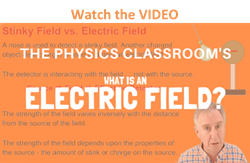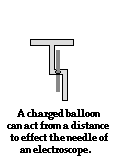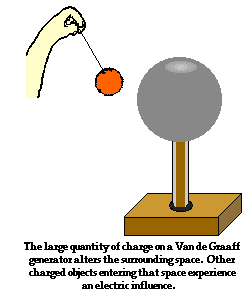The underlying and primary question being addressed in this unit of The Physics Classroom is: How can an object be charged and what effect does that charge have upon other objects in its vicinity? Early in  Lesson 1, we investigated charge interactions - the effect of a charged object upon other objects of the same type of charge, of an opposite type of charge and of no charge whatsoever. In Lesson 3, the concept of the interaction between charges was revisited and Coulomb's law was introduced to express charge interactions in quantitative terms. In Lesson 3, electric force was described as a non-contact force. A charged balloon can have an attractive effect upon an oppositely charged balloon even when they are not in contact. The electric force acts over the distance separating the two objects. Electric force is an action-at-a-distance force. In Lesson 4 of this unit, we will explore this concept of action-at-a-distance using a different concept known as the electric field. As is the usual case, we will begin conceptually and then enter into mathematical expressions that express the concept of an electric field in mathematical terms.
Lesson 1, we investigated charge interactions - the effect of a charged object upon other objects of the same type of charge, of an opposite type of charge and of no charge whatsoever. In Lesson 3, the concept of the interaction between charges was revisited and Coulomb's law was introduced to express charge interactions in quantitative terms. In Lesson 3, electric force was described as a non-contact force. A charged balloon can have an attractive effect upon an oppositely charged balloon even when they are not in contact. The electric force acts over the distance separating the two objects. Electric force is an action-at-a-distance force. In Lesson 4 of this unit, we will explore this concept of action-at-a-distance using a different concept known as the electric field. As is the usual case, we will begin conceptually and then enter into mathematical expressions that express the concept of an electric field in mathematical terms.
Electric Forces as Non-Contact Forces
 At the time that the concept of force was introduced in Unit 2 of The Physics Classroom, it was mentioned that there are two categories of forces - contact forces and non-contact forces. Electrical force and gravitational force were both listed as non-contact forces. The gravitational force, discussed in detail in Unit 6 of The Physics Classroom Tutorial, is a force that most of us are familiar with. Gravitational forces are action-at-a-distance forces that act between two objects even when they are held some distance apart. If you watch a roller coaster car move along its course, then you are witnessing an action-at-a-distance. The Earth and the coaster car attract even though there is no physical contact between the two objects. If you watch a baseball travel its parabolic trajectory at a baseball park, then you are witnessing an action-at-a-distance. The Earth and the baseball attract even though there is no physical contact between the two objects. If you watch the digested lunch of a Canadian goose land on your newly washed car, then you are witnessing (the end result of) an action-at-a-distance. The Earth and the goose do attract even though there is no physical contact between the two objects. In each of these examples, the mass of the Earth exerted an influence over a distance, affecting other objects of mass that were in the surrounding neighborhood.
At the time that the concept of force was introduced in Unit 2 of The Physics Classroom, it was mentioned that there are two categories of forces - contact forces and non-contact forces. Electrical force and gravitational force were both listed as non-contact forces. The gravitational force, discussed in detail in Unit 6 of The Physics Classroom Tutorial, is a force that most of us are familiar with. Gravitational forces are action-at-a-distance forces that act between two objects even when they are held some distance apart. If you watch a roller coaster car move along its course, then you are witnessing an action-at-a-distance. The Earth and the coaster car attract even though there is no physical contact between the two objects. If you watch a baseball travel its parabolic trajectory at a baseball park, then you are witnessing an action-at-a-distance. The Earth and the baseball attract even though there is no physical contact between the two objects. If you watch the digested lunch of a Canadian goose land on your newly washed car, then you are witnessing (the end result of) an action-at-a-distance. The Earth and the goose do attract even though there is no physical contact between the two objects. In each of these examples, the mass of the Earth exerted an influence over a distance, affecting other objects of mass that were in the surrounding neighborhood.
The action-at-a-distance nature of the electrical force is commonly observed numerous times during lab activities and demonstrations in a Physics classroom. A charged plastic golf tube might be held above bits of paper on a lab bench. The plastic tube attracts the paper bits even though physical contact is not made with the paper bits. The  charged plastic tube might also be held near a charged rubber balloon; and even without physical contact, the tube and the balloon act over a distance. The charged plastic tube exerts its influence over a distance, affecting other charged objects that were in the surrounding neighborhood. Consider a charged foam plate held above an aluminum pie plate without touching it. The charged foam plate exerts an influence upon charged electrons in the aluminum plate even though physical contact is not made. The charged foam plate exerts its influence over a distance, affecting other charged objects in the surrounding neighborhood. Consider a physics demonstration in which a charged object is brought near the plate of a needle electroscope. Prior to any contact between the electroscope plate and the charged object, the needle of the electroscope begins to deflect. The charged object exerts an influence upon charged electrons in the electroscope even though physical contact is not made. The charged object affects other charged objects that were in the surrounding neighborhood.
charged plastic tube might also be held near a charged rubber balloon; and even without physical contact, the tube and the balloon act over a distance. The charged plastic tube exerts its influence over a distance, affecting other charged objects that were in the surrounding neighborhood. Consider a charged foam plate held above an aluminum pie plate without touching it. The charged foam plate exerts an influence upon charged electrons in the aluminum plate even though physical contact is not made. The charged foam plate exerts its influence over a distance, affecting other charged objects in the surrounding neighborhood. Consider a physics demonstration in which a charged object is brought near the plate of a needle electroscope. Prior to any contact between the electroscope plate and the charged object, the needle of the electroscope begins to deflect. The charged object exerts an influence upon charged electrons in the electroscope even though physical contact is not made. The charged object affects other charged objects that were in the surrounding neighborhood.
The Electric Field Concept
As children grow, they become very accustomed to contact forces; but an action-at-a-distance force upon first observation is quite surprising. Seeing two charged balloons repel from a distance or two magnets attract from a distance raises the eyebrow of a child and maybe even causes a chuckle or a "wow." Indeed, an action-at-a-distance or non-contact force is quite unusual. Football players don't run down the field and encounter collision forces from five yards apart. The rear-end collision at a stop sign is not characterized by repulsive forces that act upon the colliding cars at a spatial separation of 10 meters. And (with the exception modern WWF wrestling matches) the fist of one fighter does not act from 12 inches away to cause the forehead of a second fighter to be knocked backwards. Contact forces are quite usual and customary to us. Explaining a contact force that we all feel and experience on a daily basis is not difficult. Non-contact forces require a more difficult explanation. After all, how can one balloon reach across space and pull a second balloon towards it or push it away? The best explanation to this question involves the introduction of the concept of electric field.
Action-at-a-distance forces are sometimes referred to as field forces. The concept of a field force is utilized by scientists to explain this rather unusual force phenomenon that occurs in the absence of physical contact. While all masses attract when held some distance apart, charges can either repel or attract when held some distance apart. An alternative to describing this action-at-a-distance effect is to simply suggest that there is something rather strange about the space surrounding a charged object. Any other charged object that is in that space feels the effect of the charge. A charged object creates an electric field - an alteration of the space in the region that surrounds it. Other charges in that field would feel the unusual alteration of the space. Whether a charged object enters that space or not, the electric field exists. Space is altered by the presence of a charged object. Other objects in that space experience the strange and mysterious qualities of the space.
The strangeness of the space surrounding a charged object is often experienced first hand by the use of a Van de Graaff generator. A Van de Graaff generator is a large conducting sphere that acquires a charge as electrons are scuffed off of a rotating belt as it moves past sharp elongated prongs inside the sphere. The buildup of static charge on the Van de Graaff generator is much greater than that on a balloon rubbed with animal fur or an aluminum plate charged by induction. On a dry day, the buildup of charge becomes so great that it can exert influences on charged balloons held some distance away. If you were to walk near a Van de Graaff generator and hold out your hand, you might even notice the hairs on your hand standing up. And if you were to slowly walk near a Van de Graaff generator, your eyebrows might begin to feel quite staticy. The Van de Graaff generator, like any charged object, alters the space surrounding it. Other charged objects entering the space feel the strangeness of that space. Electric forces are exerted upon those charged objects when they enter that space. The Van de Graaff generator is said to create an electric field in the space surrounding it.

A Stinky Analogy
With a concept such as the electric field, analogies are often appropriate and useful. While the following analogy might be a wee-bit crude, it certainly proves useful in many respects in describing the nature of an electric field. Anyone who has ever walked into a room of an infant with a soiled diaper (as in a poopy diaper) has experienced a stinky field. There is something about the space surrounding an infant's soiled diaper that exerts a strange influence upon other people who enter that space. When that little stinker needs a diaper change, you can't help but to notice it. When you walk into a room with such a diaper present, your detectors (i.e., the nose) begin to detect the presence of a stinky field. As you move closer and closer to the infant, the stinky field becomes more and more intense. And of course the worse the diaper, the stronger the stinky field becomes. It's not difficult to imagine that a soiled diaper could exert a smelly influence some distance away that would repel any nose that gets in that area. The diaper has altered the nature of the surrounding space and when your nose gets near, you know it. The stinky diaper has created a stinky field.
In the same manner, an electric charge creates an electric field - it has altered the nature of the space surrounding the charge. And if another charge gets near enough, that charge will sense that there is an effect when present in that surrounding space. And electric field is sensed by the detector charge in the same way that a nose senses the stinky field. The strength of the stinky field is dependent upon the distance from the stinky diaper and the amount of stinky in the diaper. And in an analogous manner, the strength of the electric field is dependent upon the amount of charge that creates the field and the distance from the charge.
Now all of a sudden, the discussion of electric field begins to take on a quantitative nature. Some electric fields are stronger or more intense than others. And perhaps the strength of the electric field could be measured and quantified. And clearly charge and distance seem to be two variables that affect the strength of an electric field. In the next section of Lesson 4, the quantitative nature of electric field will be discussed. The question of "How can the strength of an electric field be quantified?" will be explored. We will move beyond the mere concept of the electric field to the mathematics of the electric field.
We Would Like to Suggest ...

Sometimes it isn't enough to just read about it. You have to interact with it! And that's exactly what you do when you use one of The Physics Classroom's Interactives. We would like to suggest that you combine the reading of this page with the use of our
Coulomb's Law Interactive an/or our
Put the Charge in the Goal Interactive. Both Interactives can be found in the Physics Interactives section of our website. These Interactives provide a means of interactively exploring action-at-a-distance in an engaging environment.